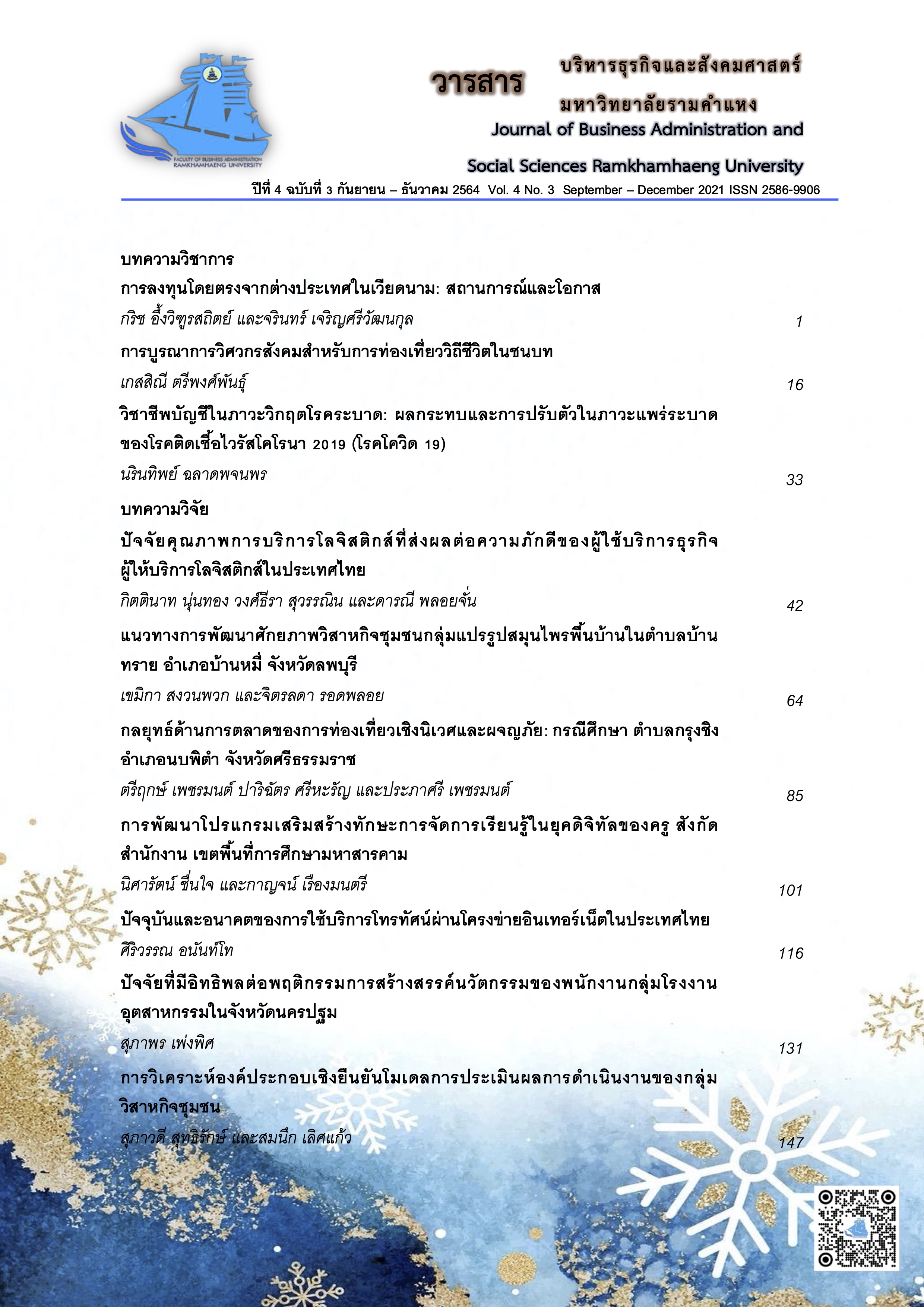Influential Factors on Innovation Work Behavior of Industrial Employees in Nakhon Pathom Province
Main Article Content
Abstract
In this research investigation, the researcher examines () the transformational leadership influencing organizational climate, work motivation, and employees’ innovation work behavior; studies 2) the organizational climate influencing work motivation and employees’ innovation work behavior; investigates 3) work motivation influencing employees’ innovation work behavior; and examines 4) the structural model consistency of factors influencing industrial employees’ innovation work behavior in Nakhon Pathom province. The research instrument was a questionnaire. The sample population consisted of 402 industrial employees in Nakhon Pathom province using the technique of random sampling. The statistics used in data analysis were percentage, mean, and standard deviation. The technique of structural equation model analysis was also employed.
Findings are as follows. 1) The transformational leadership exhibited a positive influence on organizational climate, work motivation, and employees’ innovation work behavior. 2) Organizational climate exhibited a positive influence on work motivation and employees’ innovation work behavior. 3) Work motivation exhibited a positive influence on employees’ innovation work behavior. 4) The examination of the structural model consistency of factors influencing industrial employees’ innovation work behavior exhibited congruence with the empirical data. The variables in the causal relationship of the structural equation model could be explanatory of variance at 78.7 percent.
Article Details

This work is licensed under a Creative Commons Attribution-NonCommercial-NoDerivatives 4.0 International License.
เนื้อหาและข้อมูลในบทความที่ลงตีพิมพ์ในวารสารบริหารธุรกิจและสังคมศาสตร์ มหาวิทยาลัยรามคำแหง ถือเป็นข้อคิดเห็นและความรับผิดชอบของผู้เขียนบทความโดยตรง ซึ่งกองบรรณาธิการไม่จำเป็นต้องเห็นด้วย หรือร่วมรับผิดชอบใดๆ
บทความ ข้อมูล เนื้อหา รูปภาพ ฯลฯ ที่ได้รับการตีพิมพ์ในวารสารบริหารธุรกิจและสังคมศาสตร์ มหาวิทยาลัยรามคำแหง ถือเป็นลิขสิทธิ์ของวารสารบริหารธุรกิจและสังคมศาสตร์ มหาวิทยาลัยรามคำแหง หากบุคคลหรือหน่วยงานใดต้องการนำบทความทั้งหมดหรือส่วนหนึ่งส่วนใดไปเผยแพร่ต่อ หรือเพื่อกระทำการใดๆ จะต้องได้รับอนุญาตเป็นลายลักษณ์อักษรจากวารสารบริหารธุรกิจและสังคมศาสตร์ มหาวิทยาลัยรามคำแหง ก่อนเท่านั้น
References
สำนักงานนวัตกรรมแห่งชาติ. (2552). การจัดการนวัตกรรมในยุคเศรษฐกิจขับเคลื่อนด้วยความรู้. สืบค้น
จาก http://www.nia.or.th/innolinks
สำนักงานจังหวัดนครปฐม.(2560). บรรยายสรุปจังหวัดนครปฐม ปี 2560. นครปฐม
Antoncic, B., & Hisrich, R. D. (2001). Entrepreneurship: construct refinement and cross cultural validation. Journal of business venturing. 16(5), 495-481.
Brown, W., & Moberg, D. (1980). Organization theory and management: A macro approach. New York: John Wiley & Sons.
Cherington, D. J. (1995). The management of human resources. New Jersey: Prentice Hall.
De Dreu, C. K. W., & West, M. A. (2001). Minority dissent and team innovation: The importance of participation in decision making. Journal of Applied Psychology, 86(6). 1191 -1201.
De Jong, J. P. J. (2007). Individual innovation: The connection between leadership and employee innovative work behavior (Doctoral dissertation, Faculty of Economics and Business, The Institutional Repository of the University of Amsterdam).
De Jong, J. P. J. & Den Hartog, D. (2010). Measuring Innovative Work Behavior. Creativity and Innovation Management, 19(1), 23-36.
Drucker, P. F. (1993). Post-Capitalist Society. NY: Butterworth Heinemann.
Ferreira, J. & Azevedo, S. (2007). Entrepreneurial Orientation as a main Resource and Capability on Small Firm’s Growth. Retrieved from http://mpra.ub.unimuenchen.de/5682/MPRApaperNo.5682. posted09.November2007/16: 57.
Hair, J. F., Anderson, R. E., Tatham, R. L., & Black, W. C. (2010). Multivariate data analysis with readings (4th ed.). Englewood Cliffs, NJ: Prentice Hall.
Jung, D. D., Chow, C. W., & Wu, A. (2006). Forwards understanding the direct and indirect effect of transformational leadership on firm innovation. Paper presented at the AAA 2007 Management Accounting Section (MAS) Meeting.
Kreiser, P. M., Marino, L. D., & Weaver. M. (2002). Assessing the psychometric properties of the entrepreneurial orientation scale: A multi-country analysis. Entrepreneurship Theory and Practice, 26(4), 71-93.
Li,N., Liang, J., & Crant, J. M. (2010). The role of proactive personality in job satisfaction and organizational citizenship behavior : relational perspective. Journal of applied psychology, 95(2), 395-404.
Mahaney, R. C., & Lederer, A. L. (2006). The effect of intrinsic and extrinsic rewards for developers on information systems project success. Project management journal, 37(4), 42-54.
Montes, M., & Furnandez, K. (2003). Organizational climate and relationships, to recognize and support innovation the Graduate Faculty of North Carolina State University.” Organization Behavior and Human Performance, 4(9). 75-142.
Mumford, M. D., & Gustafson, S. B. (1998). Creativity syndrome: integration, application, and innovation. Psychological Bulletin, 103, 27-43.
Nidlen. T. M., Hrivnak, G. A., & Shaw, M. (2009). Organizational citizenship behavior and performance: A meta-analysis of group-level research. Small Group Research, 40(5).555-577.
Parker, S. K., Williams, H. M., & Turner, N. (2006). Modeling the antecedents of proactive behavior at work. Journal of applied psychology, 91(3), 636.
Pinder, C. C. (1998). Work motivation in organizational behavior. Upper Saddle River, NJ: Prentice-Hall.
Schilling, M. (2008). Strategic Management of Technological Innovation (2nd ed.). NY: McGraw-Hill Education.
Shanker, R., Bhanugopan, R., Van der Heijden, B. I., & Farrell, M. (2017). Organizational climate for innovation and organizational performance: The mediating effect of innovative work behavior. Journal of vocational behavior, 100 (6), 67-77.
Roderic. G. (2007). A climate of success: Creating the right organization climate for high performance. Butterworth-Heinemann Publisher.
Slåtten, T., & Mehmetoglu, M. (2015). The effects of transformational leadership and perceived creativity on innovation behavior in the hospitality industry. Journal of Human Resources in Hospitality & Tourism, 14(2), 195-219.
Tierney, P., Farmer, S. M., & Graen, G. B. (1999). An examination of leadership and employee creativity: The relevance of traits and relationships. Personnel psychology, 52(3), 591-620.
Wiklund, J., & Shepherd, D. (2005). Entrepreneurial orientation and small business Performance: A configurationally approach. Journal of business venturing, 20(1). 71-91.
Zhan, J. (2006). Development of theory on entrepreneurial orientation: empirical evidences from Hubei, China and Flanders, Belgium (Doctoral dissertation, Ghent University). Belgium.


